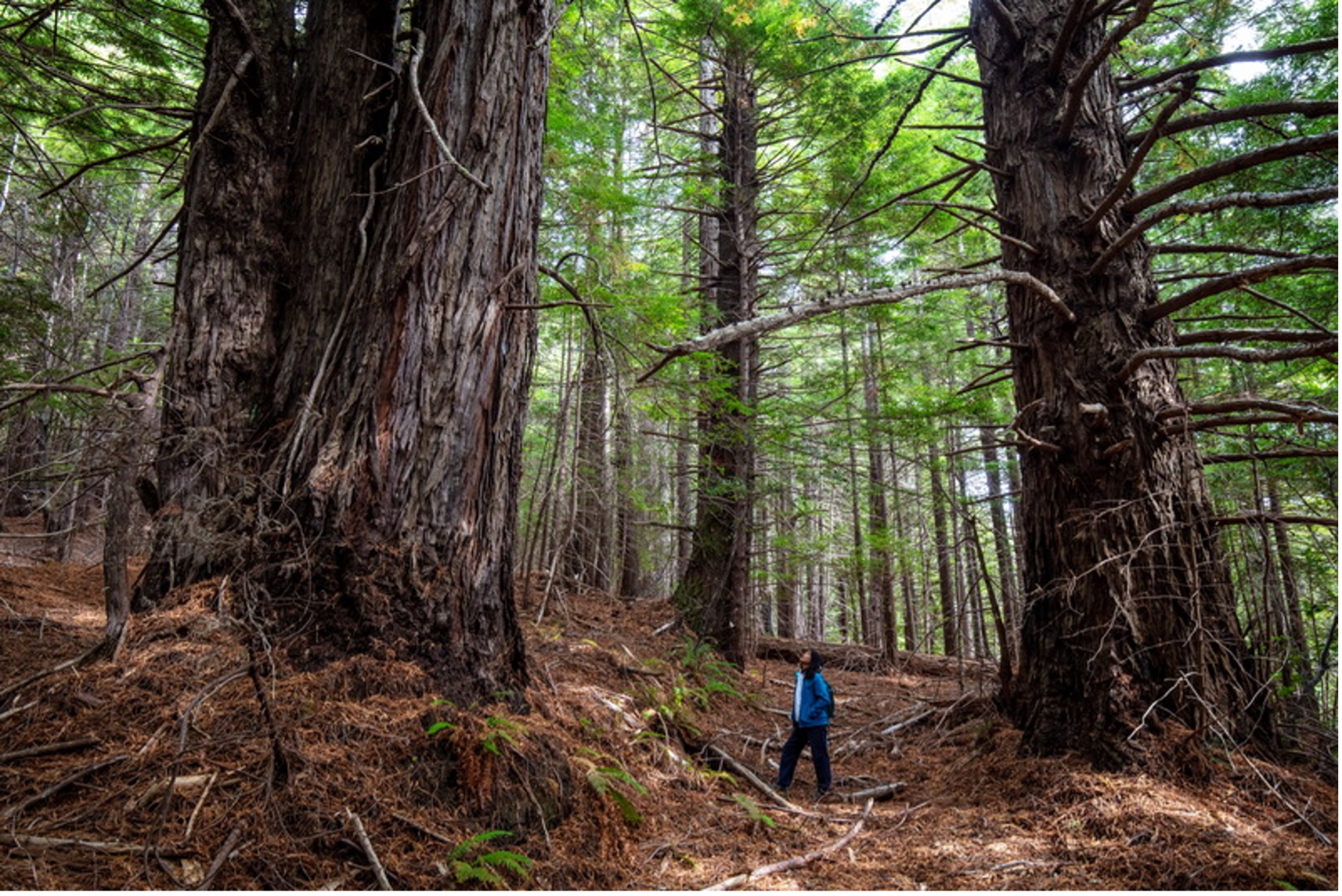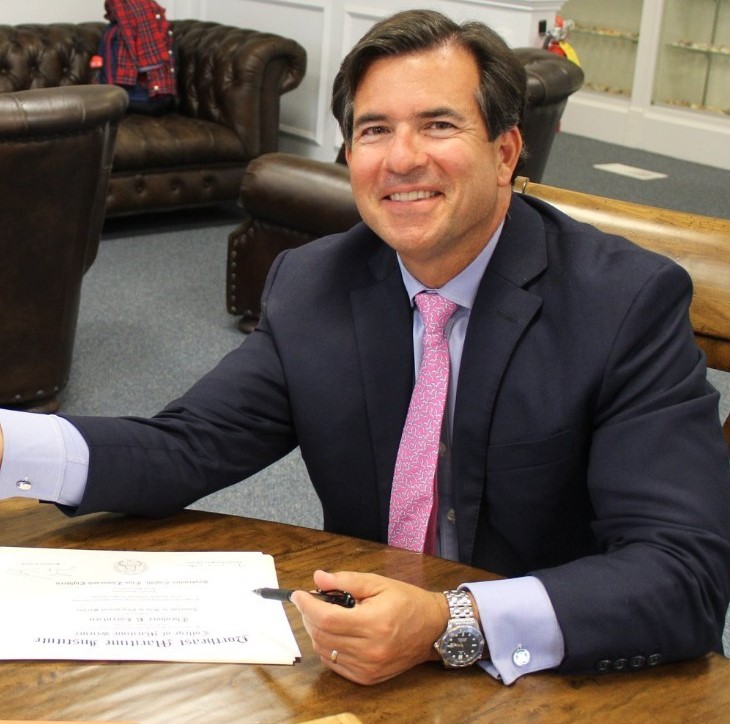 News Release
News Release
Save the Redwoods League Donates 523 Acres of Forestland to the InterTribal Sinkyone Wilderness Council for Lasting Protection
Save the Redwoods League
For a second time, Save the Redwoods League and the InterTribal Sinkyone Wilderness Council have partnered to permanently protect coast redwood forestland within Sinkyone Tribal territory on the Lost Coast in Mendocino County, California. The League purchased the 523-acre property, formerly known as Andersonia West, in July 2020. To ensure lasting protection and ongoing stewardship, the League has donated and transferred ownership of the forest to the Sinkyone Council, and the Council has granted the League a conservation easement. Through this partnership, the Sinkyone Council resumes guardianship of land from which Sinkyone people were forcibly removed by European American settlers generations ago.As an act of cultural empowerment and a celebration of Indigenous resilience, this forest will again be known as Tc’ih-Léh-Dûñ, pronounced tsih-ih-LEY-duhn and meaning “Fish Run Place” in the Sinkyone language. “Renaming the property Tc’ih-Léh-Dûñ lets people know that it’s a sacred place; it’s a place for our Native people,” said Crista Ray, who is of Eastern Pomo, Sinkyone, Cahto, Wailaki and other ancestries. Ray is a tribal citizen of the Scotts Valley Band of Pomo Indians and a board member of the Sinkyone Council. “It lets them know that there was a language and that there was a people who lived there long before now.” “Today I stand on the shoulders of giants, my ancestors … to bring them honor, and to not let our old ways be forgotten, for our next generation, my children, my grandchildren and all the kids that I’ll never get to see,” said Buffie Schmidt, who is of Northern Pomo and other ancestries. Schmidt is a tribal citizen and vice chairperson for the Sherwood Valley Rancheria of Pomo Indians and board treasurer of the Sinkyone Council. “Our ancestors are still here, they’re still around us. As I listen to the wind, I feel like my ancestors—who I’ve never even known in my lifetime—are here and happy that we call this place something that they’re familiar with: Tc’ih-Léh-Dûñ.” “The Sinkyone Council today represents the Indigenous Peoples who are the original stewards of this land. Their connection to the redwood forest is longstanding, and it is deep,” said Sam Hodder, president and CEO of Save the Redwoods League. “The League is honored to support a return of Native people to this place and to partner with the Sinkyone Council in their management and stewardship of Tc’ih-Léh-Dûñ. We believe the best way to permanently protect and heal this land is through tribal stewardship. In this process, we have an opportunity to restore balance in the ecosystem and in the communities connected to it, while also accelerating the pace and scale of conserving California’s iconic redwood forests.” Tc’ih-Léh-Dûñ is the League’s second land donation to the Sinkyone Council. The first, in 2012, was the 164-acre Four Corners property, north of Tc’ih-Léh-Dûñ. The Council also granted the League a conservation easement on Four Corners. The Four Corners project was the first League project in which Save the Redwoods entered into a conservation agreement with a tribal entity. Lasting Protections for Redwoods, Salmon and Wildlife Tc’ih-Léh-Dûñ is a coastal conifer forest with 200 acres of old-growth coast redwoods and 1.5 miles of Anderson Creek, a Class I fish-bearing stream and tributary to the South Fork Eel River. Second-growth redwoods, Douglas-fir, tanoaks and madrones also tower over a lush understory of huckleberry, elderberry, manzanita and ceanothus. This habitat corridor supports coho salmon, steelhead trout, marbled murrelet and northern spotted owl—all listed under the Endangered Species Act. Both organizations are committed to protecting redwood forests, their surrounding lands and the fish and wildlife that live there. Their partnership ensures lasting protection for Tc’ih-Léh-Dûñ, tribal stewardship of the forest, and the prevention of habitat loss, commercial timber operations, construction and development. The Council and League plan to apply a blend of Indigenous place-based land guardianship principles, conservation science, climate adaptation and fire resiliency concepts and approaches to help ensure lasting protection and long-term healing for Tc’ih-Léh-Dûñ and its diverse flora and fauna. As a Tribal Protected Area, Tc’ih-Léh-Dûñ is a vital addition to 180,000 acres of adjacent conserved lands along the Sinkyone coast. It is east of the 7,250-acre Sinkyone Wilderness State Park and located north of the 3,845-acre InterTribal Sinkyone Wilderness, which was acquired by the Sinkyone Council in 1997. The Sinkyone Council’s goal for Tc’ih-Léh-Dûñ is to help expand the matrix of neighboring protected lands that are ecologically and culturally linked, “so that tribes can achieve larger landscape-level and regional-level protections informed by cultural values and understandings of these places,” said Hawk Rosales, an Indigenous land defender who is of Ndéh (Apache) ancestry and former executive director of the InterTribal Sinkyone Wilderness Council. “In this way, Indigenous Peoples will support and participate in the healing of these lands and their communities.” According to an April 2021 United Nations policy brief, while Indigenous Peoples represent just 5% of the world’s population, they effectively manage approximately 20-25% of Earth’s land surface in areas that hold 80% of the planet’s biodiversity and about 40% of protected lands and ecologically intact landscapes. Indigenous cultural lifeways and traditional knowledge systems represent unique ways of relating to ecosystems, based upon Indigenous law and the law of nature—which, when carried out, help ensure biological diversity and abundance. Tribal nations are at the forefront of addressing climate, conservation and wildlife crises through their engagement with efforts such as the 30x30 Initiative to Protect Nature, a 10-year commitment by various tribal nations, state and federal governments, conservation organizations and others to protect and conserve at least 30% of U.S. lands and oceans by 2030 through locally led partnerships. As prominent leaders in land and water protection, the League and the Sinkyone Council are helping to advance the emerging 30x30 effort in California. “The Sinkyone Council has designated Tc’ih-Léh-Dûñ as a Tribal Protected Area. This designation recognizes that this place is within the Sinkyone traditional territory, that for thousands of years it has been and still remains an area of importance for the Sinkyone people, and that it holds great cultural significance for the Sinkyone Council and its member tribes,” stated Priscilla Hunter, who is of Northern Pomo and Coast Yuki ancestries. Hunter is a tribal citizen of the Coyote Valley Band of Pomo Indians and chairwoman of the Sinkyone Council. “The Council and the League have a mutual commitment to respect, safeguard and tend Tc’ih-Léh-Dûñ in ways that ensure its long-term protection, care and healing. In holding and caring for this land, we are helping to lead effective ways of addressing the global climate crisis.” Protection of Tc’ih-Léh-Dûñ The League’s initial purchase of this 523-acre forest for $3.55 million in 2020 was fully funded by Pacific Gas & Electric Company’s (PG&E) Compensatory Mitigation Program (program). The program seeks to develop projects related to conservation goals outlined in PG&E’s Multiple Region Operations and Maintenance Habitat Conservation Plan. Tc’ih-Léh-Dûñ supports meeting the company’s 30-year conservation goals, which were developed with the U.S. Fish and Wildlife Service (FWS). Tc’ih-Léh-Dûñ contains abundant high-quality habitat for the endangered northern spotted owl, marbled murrelet and yellow-legged frog. The long-term management and stewardship plan for the property was developed by PG&E, the League and the Sinkyone Council, and it was approved by the FWS prior to protection and donation of the land. PG&E also reimbursed the League and Council for transactional costs and management plan preparation, in addition to a $1.13 million endowment to support ongoing stewardship of Tc’ih-Léh-Dûñ. *** To schedule an interview, contact Robin Carr at (415) 971-3991 or redwoods@landispr.com. To access hi-res images and b-roll video, please visit the League’s newsroom. About the Partners: Save the Redwoods League One of the nation’s longest-running conservation organizations, Save the Redwoods League has been protecting and restoring redwood forests since 1918. The League has connected generations of visitors with the beauty and serenity of the redwood forest. The nonprofit’s 29,000 members have enabled the organization to protect more than 216,000 acres of irreplaceable forests in 66 state, national and local parks and reserves. For information, please visit SaveTheRedwoods.org. InterTribal Sinkyone Wilderness Council Founded by Tribal Nations that have protected the earth for millennia, the InterTribal Sinkyone Wilderness Council is a non-profit consortium of 10 Tribes whose legacies are rooted in deep intergenerational relationships of reciprocity with cultural landscapes and seascapes cared for in ways to ensure biological diversity and abundance. The Council conducts Indigenous protection, conservation and guardianship work within Sinkyone and adjacent Tribal territories. For information, please visit Sinkyone.org. Contact Details Landis Communications Inc. Robin Carr +1 415-971-3991 redwoods@landispr.com Company Website https://www.savetheredwoods.org/
January 25, 2022 12:01 AM Pacific Standard Time
Image
 News Release
News Release






